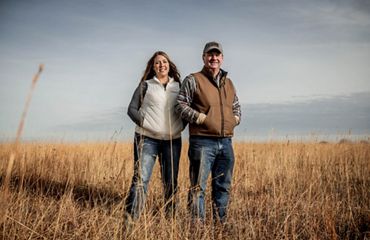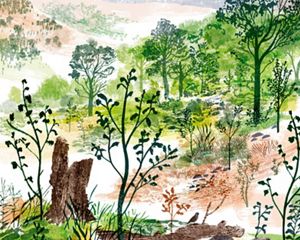A Pathway to Farming
Meet the Kansas nonprofit trying to keep small farms alive by teaching military veterans about sustainable agriculture.
By Benjamin Tepler, Freelance Writer | Spring 2022
Every six months, a Kansas nonprofit organization called SAVE and its leader, Tod Bunting, a former major general in the National Guard and Air Force, welcome a new cohort of students—many of them military veterans. The group, whose name stands for Servicemember Agricultural Vocation Education, aims to teach its students the basics of sustainable farming.
The 440-hour certificate program, based on 308 acres of farmland near Fort Riley and Kansas State University in Kansas, includes everything from classroom lessons on agribusiness and animal science to hands-on water management and farm equipment operations. SAVE hopes to enroll 100 students a year post-pandemic. While civilians and veterans without disabilities can join the certificate program, special attention is given to disabled former soldiers, who have access to various types of therapy, rehabilitation and peer support throughout the program.
To help guide these new farmers, The Nature Conservancy is working in partnership with SAVE on portions of the sustainable-farming curriculum, including water conservation techniques and more efficient fertilizer use that reduces pollution in rivers. Heidi Mehl, the director of water and agriculture for TNC in Kansas, joins Bunting to discuss how the six year-old group is trying to create a new generation of water-smart family farmers.
How does a retired major general end up running a farm program for vets?
Bunting: I was recruited because I believed in the mission. In my tenure [as adjutant general of the Kansas National Guard], we had started a resiliency program in Kansas in 2007, because at that time we had five soldiers killed in action, and we had had five suicides. And I sat down with my sergeant major and said: “I’m gonna fight one enemy at a time.” That’s my core, and that’s what the SAVE farm is all about. It’s a pathway to farming, but also a kind of tangible place that veterans can go to get the therapy that comes from being outdoors and hopefully being in farming.
Why farming?
Bunting: If you were to ask, “Who is the person you are the most intent on helping?” it would be the soldier who doesn’t have any purpose in life right now. Based on their injuries, they are probably not a match for an 8-to-5 job. One of our founders, [retired Army Col.] Gary LaGrange, is a three-tour Vietnam veteran and has PTSD. He found great solace a number of years ago in beekeeping—that’s his particular passion. Beekeeping is unequivocally a great therapy. We have research ongoing, and a significant amount of data we’re keeping that [shows] just being outside and farming is a form of therapy and healing.
Some of my guys, the fear for them, because of a variety of things—anxiety and depression—was basically [that they’d turn into] a “neutral,” where they are heavily sedated and can function, but they sit on the porch all day while their kids run around. But if we get them into a high tunnel [a greenhouse], or a victory garden, or an orchard, or maybe even a very small cow-calf operation, they have meaning. They have purpose. There’s something tangible.
Quote: Tod Bunting

“We are trying to solve this issue with SAVE: How do we keep the family farm? How do we make sure we don’t go entirely corporate farming?”
Heidi—how did you (and TNC) get involved?
Mehl: SAVE has a 308-acre training ground north of Manhattan, Kansas [that they were leasing], and the landowner decided that they wanted to sell it. SAVE had put all of this time and effort and infrastructure into this land and there was a possibility of losing that and being back to zero. So in 2020, we partnered with [fellow nonprofit] The Conservation Fund to provide a loan to buy the property. It secured SAVE’s training ground.
And now you’re helping advise the program. Tod, why teach sustainable and regenerative agriculture specifically?
Bunting: If you take the time to set [a farm] up right—working with Heidi and others there’s a way for you to do way more on less land than your father or mother might have done. So much of what we’re doing now is actually the way we did farming 100 years ago. And then we got all involved with big equipment and chemicals. Very little of what we’re doing at SAVE is new, but it’s new to this generation. That gives us confidence that with the resources Heidi can teach us, we can [survive] the droughts and everything else that has plagued us.
We actually teach two weeks’ worth of water: proper watering, water quality and things of that nature. Our ultimate goal is that any water that comes on our farm stays on our farm. When you get that inch of rain, it’s all going to come to you, not half of an inch and the rest makes its way into Tuttle Creek reservoir.
What does Tod mean about keeping rain out of the reservoir?
Mehl: There’s a famous freshwater ecologist named H.B.N. Hynes who coined the phrase “The valley rules the stream.” The idea is that everything that happens on the land in the watershed is going to affect the hydrology—the way that water is running off. Is it infiltrating into the soil? Is it having a chance to filter and remove pollutants? Or is it running over concrete and bringing hot, polluted water into the stream?
The healthier the soil is, the more you build organic carbon—and the better infiltration and more water-holding capacity those soils are going to have. The soil acts like a sponge. As the sponge fills up, you’re adding resiliency into your cropping system. If you have a drought and your soils are more spongy, you’re going to weather it much better.
What’s the current state of water quality in Kansas?
Mehl: The Kansas Department of Health and Environment did an analysis and found that 86% of streams in the state are impaired by pollution. Meanwhile, about 800,000 people get their drinking water from the Kansas River. The more we get pollutants in the water, the more we have to pay to clean them. What’s the breaking point? Are we going to pay forever to continue to try and clean the water, or do we look at the way we are using the land and use nature-based solutions and ecosystem services to provide a cleaner water supply?
Are landowners in Kansas trying those things already?
Mehl: When I drive around now, I’m always looking at the different fields, especially [in the fall]: Do they have cover crops, or have they tilled it up and left it bare? And there are still some that do, but just yesterday I was driving by a field in western Kansas that left their corn stubble—so they left the armor on the soil. They had the cows grazing it out, so they are doing the animal integration. That’s two out of the five pieces of the soil health puzzle. It’s really great to see how many farms are integrating at least pieces of those practices.
Why don’t more people switch from conventional to sustainable farms?
Bunting: They cost more in the short term. Most of them are labor-intensive. And there’s a shortage of both [money and labor]. For a new farmer, it’s so hard to get started. I don’t like to say that because I’m trying to encourage people to become farmers, but I feel like I gotta look them in the eye and go: “OK, this is not going to be easy.”
Mehl: I completely agree. If you are supporting your family with agriculture, there’s a lot of risk involved. There’s no guaranteed income year after year. And when you have something that works and it’s the way your dad and grandpa did it, it’s a hard ask to come in and say: “You need to change everything that you’ve done and that you know works. You might lose money for a couple of years, but in the long term…” That’s a pretty tough sell. And I get that. I don’t know how I would react if someone came in and said, “Hey why don’t you take a hit to your salary for a couple of years.”
You’ve talked about how family farms are a dying breed. How bad is it really?
Bunting: We are trying to solve this issue [with SAVE]: How do we keep the family farm? How do we make sure we don’t go to entirely corporate farming? There’s a little wiggle room, but somewhere in the mid-60s is generally accepted as the percentage of farms in America that are in their final generation. Not everyone in farming believes that this is a problem though.
How do you envision SAVE helping to change that?
Bunting: Since 2016 we’ve probably had 300 graduates go on to involvement in beekeeping, farming or a job in agriculture. We have a pretty significant comparative agriculture program, which we call “farm tours,” and that’s where soldiers come out for one or two weeks [to visit local crop or animal farms and agribusiness programs in Kansas]. But we don’t have a good eye on where they end up, because they don’t come through our formal program.
Our dream all along has been to be a model for the country and for other land grant universities. Our long-term goal is to graduate 50 to 100 students a year, with a high percentage going into farming. Ideally, within 10 years of graduating, we want at least half of them to have their own farm and flatten that trend of decreasing farmers in America. As part of that, [we want] to show that this type of career transition from the military can stem the tide and reverse the national trend of more than 17 [veteran] suicides a day.




